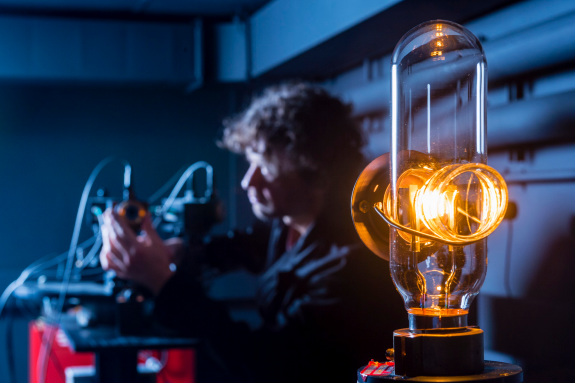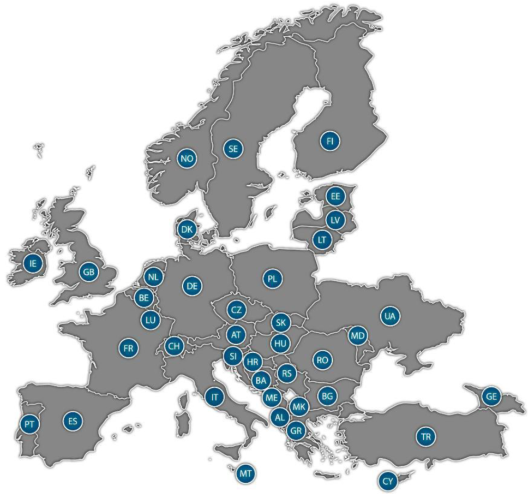
EURAMET e.V. is an association of national metrology institutes (NMI) created on January 11, 2007. It is the regional metrology organization (RMO) for Europe, of which LNE is the member representing France.
As part of the CIPM Mutual Recognition Arrangement (CIPM MRA) of the equivalence of national standards and calibration and measurement certificates issued by NMIs, EURAMET assumes by delegation certain actions for its implementation (in particular the reviews of the quality management systems of each member state).
EURAMET
EURAMET e.V. follows on from the EUROMET association founded in Madrid in September 1987. EUROMET originally included the national metrology institutes of the countries of the European Union and the European Free Trade Association (EFTA). It then integrated, as and when they joined, the new member countries NMIs of the European Union. Other NMIs of countries, not yet members of the European Union at that time, were also full members of EUROMET, such as Turkey and Serbia, for example. EUROMET was dissolved in June 2007, and all its activities were transferred to EURAMET.
EURAMET e.V. is a non-profit association under German law. In 2024, it comprises 39 member countries of the European Union, EFTA countries and states wishing to join the European Union.
EURAMET was set up to develop cooperation of all kinds between the national metrology institutes of Western Europe (NMIs) and to ensure efficient use of available metrology resources. Since its creation, EURAMET has focused on cooperation in research and development.
The objectives of EURAMET
The objectives of the association are numerous, we will quote the following:
- Promoting European metrology and its scientific results;
- Create a community of metrological experts to facilitate technical exchanges via specific groups and/or projects of common interest;
- To develop genuine collaboration between all the members of the association on research projects relating to measurement standards, inter-laboratory comparison projects, in a European structure ;
- Optimize the use of resources and services available to members to meet identified industrial or societal metrological needs;
- Improve calibration capabilities and make them accessible to all members by providing better visibility;
- Support countries that set up references and ensure knowledge transfer from one country to another as necessary.
EURAMET's specific tasks
- cooperation on studies and research to improve references in metrology or to produce new references;
- coordination of major investments in metrological resources;
- the transfer of skills and knowledge between members, in particular through the creation of specific technical groups to facilitate exchanges;
- the establishment of a framework for collaboration among members interested in a specific project;
- the organization of international comparisons, in particular following the implementation of the MRA published by the CIPM;
- the provision of information on resources and services;
- cooperation with European accreditation agencies;
- cooperation with European legal metrology services.
Structure and technical activities
Each signatory member (for France, the LNE) mandates one delegate. All delegates constitute the EURAMET General Assembly. It meets at least once a year to discuss the objectives and strategy to be developed within the European Metrology Association.
The President of EURAMET is elected for three years by the General Assembly. His mandate is not renewable; he is assisted by a secretariat and two vice-presidents, also elected by the General Assembly.
The First Vice-President is dedicated to EURAMET's own activities.
The second vice-president (vice-president research) is statutorily the president of the EPM Committee (European Partnership on Metrology). Each NMI from EURAMET member countries involved in the EPM program mandates a representative to the EPM committee. To date, 23 country NMIs out of the 39 EURAMET member country NMIs participate in the EPM program.
A Board of Directors (BoD), composed of nine members (including the President and his 2 Vice-Presidents, and 6 other members elected among the delegates of the General Assembly) ensure the functioning of the latter between two General Assemblies, and assist the President in his function.
Furthermore, EURAMET has become more professional with a multi-component office in order to better respond to the various activities of the association: legal and financial aspects, procedures and specific follow-up of research projects within the EPM framework (JRPs - Joint Research Project), projects financed by the European Union, activities linked to projects defined within the technical committees, quality assurance management in laboratories, inter-laboratory comparisons, etc.
Moreover, the joint committee STAndards, Innovation and Research - European Mettrology Programme for Innovation and research (STAIR-EMPIR), is a platform for exchange between CEN-CENELEC (standardisation) and EURAMET (metrology), to define R&D needs with an impact on standardisation.
To ensure EURAMET's technical activity, specific groups have been created: Technical Committees (TCs). There are currently twelve of them, 10 of which relate to technical activities and 2 to transverse activities:
- mass (including force, torque and pressure) ;
- length (including dimensional measurements) ;
- electricity and magnetism (direct current and quantum metrology, low frequency, high frequency) ;
- time and frequency ;
- thermometry (including thermal properties and humidity) ;
- ionizing radiation (dosimetry, radioactivity, neutron metrology) ;
- photometry and radiometry (including fiber optics) ;
- flowmetry (liquid and gas) ;
- acoustics, ultrasound and vibration (including accelerometry) ;
- chemical metrology (gas, organic, inorganic and electrochemistry) ;
- interdisciplinary metrology ;
- quality.
Each EURAMET member country NMI may designate a "contact-person", specialist in the field concerned, to represent it on each of the technical committees. For each TC, a TC Chairperson is elected by all the Contact Persons of the TC concerned; his term of office is two years, renewable once. Its main tasks are the coordination of the projects presented by the contact persons and the animation of the Technical Committee.
Given the volume of activity of some committees, but also the technical diversity of these areas, some TCs have been subdivided into sub-groups. This is for example the case for electricity with subcommittees in low frequency, quantum metrology, power and radio frequencies.
Each collaboration project, of a specific domain, is classified in one of the following categories:
- cooperation in research
- intercomparison of measurement standards
- calibration service offer (traceability)
- consultation on facilities
Currently, around 1000 projects have been initiated in 20 years by EUROMET. The substantial number of projects is proof of EUROMET's, and now EURAMET's, success in terms of European collaboration in research and knowledge transfer.
With the implementation of the CIPM MRA, the projects on inter-laboratory comparisons had an unprecedented growth in the following 5 years. These comparisons are used to demonstrate the equivalence of national standards. Collaborations for joint research and development projects is the most appreciated type of collaboration; this indicates the obvious willingness of metrologists to share their work.
European research programmes
Research is very expensive and requires considerable resources, both human and in terms of the most sophisticated equipment. Since redundancy is also essential in metrology, particularly at the highest level of implementation, it must be reconciled with a fair optimization of the means implemented. EUROMET made it possible to generate joint research and development projects, based on voluntary partnership and on the own funds of each participating country. With new and growing areas of metrology, such as nanosciences, biotechnology, medicine, software and modelling, materials, health, imaging, perception metrology, security and space, and many others, additional resources were needed.
The European Union, aware of these challenges, has proposed to develop and finance a metrology research programme, for better synergy and greater scientific cooperation between States in Europe. Several steps were necessary.
- A first programme, i-MERA (Implementing Metrology European Research Area), from 2005 to 2008 identified strategic research activities to support innovation and quality of life in Europe, developed a European Metrology Research Programme (EMRP), and looked at solutions for the management of such a project. Hence the creation of the legal entity "EURAMET" in 2007.
- This first stage was followed by a transitional phase, i-MERA+, a test phase for financing European projects. A €64 million programme (32% financed by the European Commission and the rest by the Member States) financed 21 projects
- At the end of this transitional phase, two European metrology research programmes were successively created: EMRP (European Metrology Research Programme), from 2009 to 2013 for calls for projects with a funding of 400 M€ (50% financed by the EC). 119 projects were finalised. Then EMPIR (European Metrology Programme for innovation and Research), for a 600 M€ financing (50 % financed by the EC) from 2014 to 2020. 236 projects were finalised.
The themes of the projects financed are defined by the EPM Committee and present important societal or economic issues such as health, the environment, energy, industrial needs, new technologies or the fundamental aspect of redesigning the international system of units.
The EPM program
The European Partnership for Metrology, also known as the European Partnership on Metrology (EPM), is a major initiative integrated into the "Horizon Europe" program and dedicated to research in the field of measurement, co-financed by the Union European and participating states. The program is organized into 7 annual calls for projects launched between 2021 and 2027. EURAMET is responsible for implementing this partnership. The forecast budget for the EPM is around €690 million, including €300 million co-financed by the European Commission.
The EPM follows the EMPIR program (European Metrology Program for Innovation and Research), whose last call for projects took place in 2020. The EPM, like EMPIR, are Articles 185 of the Treaty on the Functioning of the European Union (TFEU), initiatives for public-public partnerships between EU member states, which allows the management of a program to be left to a third party; for the EPM, it is therefore EURAMET.
The main areas of action of the European Metrology Partnership include:
1. Research and innovation: the program actively supports fundamental and applied research in the field of metrology. This includes the development of new measurement methods, cutting-edge instruments, the integration of new technologies for calibration benches and ensuring the traceability of measurements.
2. Harmonization of standards and practices: the EPM works to develop common metrological standards and good practices across Europe, thus ensuring the comparability of measurement results and facilitating international trade.
3. technology transfer and industrial innovation: the partnership encourages collaboration between research institutes and companies to accelerate the transfer of advanced metrological technologies to industry. This helps improve product quality and strengthen European competitiveness.
4. Training and skills development: EPM promotes training and skills development in metrology by offering training programs, thematic summer schools, workshops and exchanges between experts. This ensures the availability of qualified professionals to support metrology in various sectors.
5. Awareness raising and dissemination of knowledge: the program strives to raise awareness among the general public and policy makers of the importance of metrology for society. It also facilitates the dissemination of knowledge and research results in the field.
The European Partnership for Metrology thus contributes to improving the quality of life of European citizens by guaranteeing the reliability of measurements used in the fields of health, safety, environment, energy, industry and scientific research. It also promotes technological development and innovation, thus strengthening the competitiveness of European industry on the global market. Thanks to funding and support from the European Commission, the EPM plays a crucial role in the promotion and coordination of metrology at European level.
To participate in EPM calls for projects: HTTPS://METPART.EU/.
The RNMF and EURAMET
Within the EURAMET association, the RNMF is active at all levels.
It was one of the initiators of the creation of the EUROMET association in 1988, with the PTB (Germany) and the NPL (United Kingdom), then of its transformation into a legal entity in 2007, to become EURAMET.
All laboratories, according to their competence, participate in technical committees, thematic groups (environment, energy, health) and inter-laboratory comparisons organized within this framework, among others.

